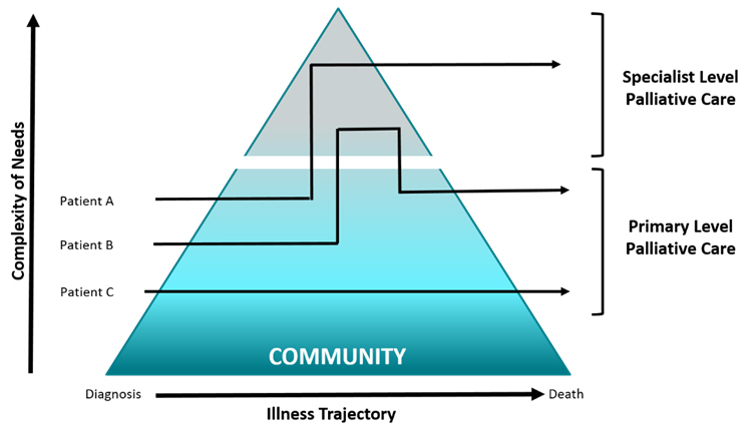A Typical Hospice Team Includes Which of the Following
A hospice care team typically includes. A chaplain for spiritual support and to connect the family with members of their faith community.
This includes teaching for.

. Pain and symptom management for the patient b. The services that the Medicare Hospice Benefit covers are. The maintenance of personal hygiene is essential for an individuals self-esteem and quality of life.
Bereavement dietary spiritual Hospice aides must receive hours of in-service training during a 12-month period. A social worker to counsel and connect families with strong community support systems. Education for patients and medical care providers is a top priority.
Teaching is a primary function of Hospice. All of the following are typical hospice team members EXCEPT. Hospice will surround you as the caregiver and the patient with a team experienced in providing end-of-life care.
The hospice nurse makes regularly scheduled visits to the patient providing expert pain management and. In general the interdisciplinary hospice team will include the following. Caregivers and other family members.
These supplies might include for example a hospital bed a wheelchair and oxygen as well as adult diapers bandages and latex gloves. This team approach to care for dying persons typically includes a physician a nurse a home health aide a social worker a chaplain and a volunteer. Bereavement counseling for the family up to one year after the patients death c.
Pain control is not the primary object for hospice in some countries. A primary care doctor and a hospice doctor or medical director will oversee care. A- The main goal of palliative care is cure while hospice care begins when nothing else can be done.
Childrens specialists to help children cope with a loved ones illness Home health aides. All of the following are typical hospice team members EXCEPT. The hospice interdisciplinary team includes the following members.
C- Hospice care is only for those with cancer while palliative care is appropriate with other diagnoses. Our caregivers can provide the following services. Although hospice provides a lot of support the day-to-day care of a person receiving hospice care is provided by family friends the inner circle or paid home health aides.
Hospice aides may be supervised by either a registered nurse or a licensed practical nurse. Case management workers. Doctor services Nursing Care Medical equipment such as hospital beds wheelchairs or walkers Medical supplies such as bandages and catheters Drugs to control pain and other symptoms Home health aide and homemaker services Physical and occupational therapy.
QUESTION 2 Which of the following is NOT a typical part of hospice care. Hospice provides the equipment necessary to provide a safe comfortable caring environment in the patients home. Hospice care includes the following.
B- Hospice care provides palliative care at the end-of-life. Hospice care is growing rapidly throughout much of the world. Conveys te patients wishes.
Coordination of all medical services. Hospice care is usually provided by a team of individuals that includes. The hospice team coaches caregivers on how to care for the patient and.
A typical hospice team consists of. A bereavement team. The four levels of hospice include routine home care continuous home care general inpatient care and respite care.
Services of a doctor physicians assistant or nurse practitioner Nursing services Hospice aide services Physical therapy Occupational therapy Speech-language pathology services Social services Medications for pain and other symptoms Nutrition counseling Spiritual support Medical supplies Durable medical equipment 3 Level 2. The care is provided in your home nursing home assisted living or inpatient hospice facility. In addition to clinical staff the hospice interdisciplinary group includes a pastoral or other counselor who offers spiritual support and comfort.
All of the following are true of the hospice movement internationally EXCEPT that. Hospice staff is on call 24 hours a day seven days a week. One of the ways that our professional caregivers can support hospice patients is by administering respectful personal hygiene services.
Physician RN social work pastoral or other counselor Counseling services includes the following. Chaplain services provide spiritual support. If youre not receiving hospice care at a dedicated facility hospice staff will make regular visits to your home or other setting.
The team consists of professionals from multiple disciplines who not only address the physical distress associated with dying. Hospice aides offer personal care and support to the patient. Which is not a member of the Hospice team.
Asked Sep 1 2017 in Health Professions by Gatormerve. Search for an answer or ask Weegy. Hospice physicians direct patient care treatments and consult with the patients regular physician if.
False Only RN 14. Symptom control and management also known as palliative care pain management stress management and other mental health support spiritual support family support. They address all needs associated with the dying process.
Home health aide s Nurse s Hospice physician or medical director Personal physician may also be included Social worker s Trained volunteer s Clergy or other counselor s Speech physical and occupational therapist s if needed 24-Hour Support Hospice care is available around the clock. Hospice offers four levels of care as defined by Medicare to meet the varying needs of patients and their families. D- Hospice care and palliative care are the same thing.
An aide for personal care companionship and support.

Hospice Care End Of Life Process Timeline Compassus

Who Provides Palliative Care And Where Ontario Palliative Care Network

Integrating Palliative Care Perspectives For Nurses And Doctors Ppt Download


Comments
Post a Comment